Arati Narayan
Herbs and spices have been a part of our culture from the time of the Rig Veda and the virtues of turmeric, saffron, and cardamom have been extolled in many of our ancient writings. In fact, no recipe in India is complete without its dose of spices. And while the general reason is to enhance flavour, the purpose of using spices in food does go much deeper. While the Chinese prefer ginger, in ancient Greece and Rome, cinnamon, considered the spice of love, was favoured.
Spices were always valuable. In ancient times they were considered a reflection of wealth and were used to bargain and trade. People have set out by sea and land in search of them! Spices were used not just in culinary preparations but also as medicines and in perfumes. They were known for their antiinflammatory properties and their ability to prevent disease and enhance moods.
It’s difficult to imagine an Indian kitchen without its herbs and spices. They come in various forms (leaves, bark, flowers, seeds, roots, etc.), can be used in various forms (fresh, dried, crushed, powdered), and play a major role in altering the colour, aroma, flavour, and taste of food.
A healthy diet is not just about fruits and vegetables. While herbs and spices are commonly used in a variety of recipes, many people are not aware that they can provide amazing health benefits! Indian cooking involves the use of many spices with most dishes having ingredients like ginger, turmeric and cumin, and herbs like coriander. Apart from the “zing” they bring to the food, they provide many disease-preventing nutrients. From the nutrition point of view, the antioxidants you would get from consuming a portion of red tomatoes or grapes, you would find in just half a teaspoon of cumin seeds or dried ginger.
Here is some information on the nutritive value of commonly used herbs and spices and more ways to incorporate them into your diet and day-to-day cooking.
 Saffron – A pinch of the queen of all spices, originally from Kashmir or Spain, added to warm cow’s milk will keep you warm in the cold months and keep colds at bay. It’s known to rejuvenate skin, cure depression, and lower blood pressure. Given its properties, it is considered a must for to-be mothers but must be consumed only in culinary amounts. It is the world’s most expensive spice and has a distinctly warm, powerful flavour, with no substitute. While it is available in a grounded form, using the strands ensures its quality. Saffron has a long history, and back in the days of Cleopatra was actually used as a hair dye.
Saffron – A pinch of the queen of all spices, originally from Kashmir or Spain, added to warm cow’s milk will keep you warm in the cold months and keep colds at bay. It’s known to rejuvenate skin, cure depression, and lower blood pressure. Given its properties, it is considered a must for to-be mothers but must be consumed only in culinary amounts. It is the world’s most expensive spice and has a distinctly warm, powerful flavour, with no substitute. While it is available in a grounded form, using the strands ensures its quality. Saffron has a long history, and back in the days of Cleopatra was actually used as a hair dye.
 Cardamom or elaichi – known as the “grains of heaven” for their unique flavour, improve digestion, and blood circulation. Cardamom acts as a detoxifying agent and has been mentioned in the Vedas for its property of balancing the three doshas – vata, pitta, and kapha. It comes in three colours–black, white, and pale green. The pale green variety is the most preferred. The black seeds in the cardamom pod provide the flavour and fragrance. Hence, crush the pods before using them, whether in chai, curries, or in desserts.
Cardamom or elaichi – known as the “grains of heaven” for their unique flavour, improve digestion, and blood circulation. Cardamom acts as a detoxifying agent and has been mentioned in the Vedas for its property of balancing the three doshas – vata, pitta, and kapha. It comes in three colours–black, white, and pale green. The pale green variety is the most preferred. The black seeds in the cardamom pod provide the flavour and fragrance. Hence, crush the pods before using them, whether in chai, curries, or in desserts.
 Cinnamon or dalchini – can warm up and liven the flavours of the food as well as lower cholesterol, manage blood sugar levels and keep arteries healthy. When consumed it can reduce the pains associated with arthritis. It is known to have antibacterial, antifungal and anti-parasitic properties and is often used as a natural food preservative as it inhibits the growth of bacteria. While cinnamon powder is not frequently used in Indian cooking, adding just half a teaspoon to a meal a day can help reduce the risk of type 2 diabetes. Cinnamon is a good source of iron, magnesium, calcium, and fibre and it has been said that simply smelling cinnamon can improve memory and cognitive function. The whole sticks are used to flavour meats, curries, as well as teas.
Cinnamon or dalchini – can warm up and liven the flavours of the food as well as lower cholesterol, manage blood sugar levels and keep arteries healthy. When consumed it can reduce the pains associated with arthritis. It is known to have antibacterial, antifungal and anti-parasitic properties and is often used as a natural food preservative as it inhibits the growth of bacteria. While cinnamon powder is not frequently used in Indian cooking, adding just half a teaspoon to a meal a day can help reduce the risk of type 2 diabetes. Cinnamon is a good source of iron, magnesium, calcium, and fibre and it has been said that simply smelling cinnamon can improve memory and cognitive function. The whole sticks are used to flavour meats, curries, as well as teas.
 Turmeric or haldi – is considered to be the number one health-benefiting spice in Ayurveda and is often called ‘the spice of life’. The chemical, curcumin, in turmeric (causes the intense yellow colouring) is what provides turmeric with its antiinflammatory properties and enables it to treat skin conditions, strengthen bones, and improve immunity. Turmeric also helps in lowering cholesterol, and protecting the liver. Turmeric powder can be used in a number of ways. It can directly be applied on swellings and abscesses. It can also be consumed with a little milk at night to keep body pains and colds at bay. However, it is most often used in dishes containing meat or onions. Turmeric is also a very powerful antioxidant and can help prevent diseases such as cancer, arthritis, and Alzheimer’s, and slow the aging process of the body. Turmeric was actually called “Indian Saffron” in medieval Europe.
Turmeric or haldi – is considered to be the number one health-benefiting spice in Ayurveda and is often called ‘the spice of life’. The chemical, curcumin, in turmeric (causes the intense yellow colouring) is what provides turmeric with its antiinflammatory properties and enables it to treat skin conditions, strengthen bones, and improve immunity. Turmeric also helps in lowering cholesterol, and protecting the liver. Turmeric powder can be used in a number of ways. It can directly be applied on swellings and abscesses. It can also be consumed with a little milk at night to keep body pains and colds at bay. However, it is most often used in dishes containing meat or onions. Turmeric is also a very powerful antioxidant and can help prevent diseases such as cancer, arthritis, and Alzheimer’s, and slow the aging process of the body. Turmeric was actually called “Indian Saffron” in medieval Europe.
 Ginger or adrak – needs no introduction. It is available fresh and dried (ground into pieces). Fresh ginger is often ground into a paste, finely chopped, or made into juice or brewed in tea. With its refreshing and warm aroma, ginger finds its way into many dishes. Drinking adrak chai can keep the colds and flu at bay. In Chinese medicine, ginger tea is used to treat migraines, nausea, and menstrual cramps. Ginger, like cinnamon, has anti-inflammatory properties and is a powerful natural painkiller.
Ginger or adrak – needs no introduction. It is available fresh and dried (ground into pieces). Fresh ginger is often ground into a paste, finely chopped, or made into juice or brewed in tea. With its refreshing and warm aroma, ginger finds its way into many dishes. Drinking adrak chai can keep the colds and flu at bay. In Chinese medicine, ginger tea is used to treat migraines, nausea, and menstrual cramps. Ginger, like cinnamon, has anti-inflammatory properties and is a powerful natural painkiller.
 Garlic or lasan – is more known for causing bad breath than its anti-fungal, anti-bacterial and antiviral effects. Fresh garlic – whether whole, chopped or ground – is favoured by cooks all over the world for the pungent flavour it brings to the dish. It is most often used for fl avouring meats, lentils, and soups. Garlic is said to have the ability to relieve asthma, lower cholesterol, and enhance metabolism. Its property of flushing out toxins aids in digestion and relieving acne. After a meal with garlic, you can chew on any of these natural mouth fresheners – clove buds, cinnamon sticks, or cardamom seeds.
Garlic or lasan – is more known for causing bad breath than its anti-fungal, anti-bacterial and antiviral effects. Fresh garlic – whether whole, chopped or ground – is favoured by cooks all over the world for the pungent flavour it brings to the dish. It is most often used for fl avouring meats, lentils, and soups. Garlic is said to have the ability to relieve asthma, lower cholesterol, and enhance metabolism. Its property of flushing out toxins aids in digestion and relieving acne. After a meal with garlic, you can chew on any of these natural mouth fresheners – clove buds, cinnamon sticks, or cardamom seeds.
 Cumin or jeera – has been discovered to have what it takes to block the action of bacteria that cause food poisoning. Research has also shown that cumin can help fight diabetes, prevent cataract, and osteoporosis. Cumin is rich in vitamin A and C. As a strong antioxidant, it can help prevent cancer and strengthen the immune system. Cumin enhances the appetite and protects against anemia. It also helps deal with chest congestion and diarrhoea. Cumin can be consumed in jal jeera or sautéed in oil for daltadka and curries.
Cumin or jeera – has been discovered to have what it takes to block the action of bacteria that cause food poisoning. Research has also shown that cumin can help fight diabetes, prevent cataract, and osteoporosis. Cumin is rich in vitamin A and C. As a strong antioxidant, it can help prevent cancer and strengthen the immune system. Cumin enhances the appetite and protects against anemia. It also helps deal with chest congestion and diarrhoea. Cumin can be consumed in jal jeera or sautéed in oil for daltadka and curries.
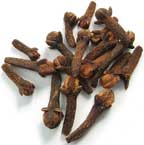 Cloves or laung – help relieve nausea, stomach upsets, muscle cramps, and toothaches. Homemade chai with simmering milk, cardamom pods, cinnamon, and cloves soothes sore throats. Adding star anise increases antioxidants, which help fight infection. Cloves also relieve joint inflammation. Fresh cloves can be chewed on as a mouth-freshener. They are also an important ingredient in garam masala. Sautéing cloves in hot oil, releases and enhances their aroma.
Cloves or laung – help relieve nausea, stomach upsets, muscle cramps, and toothaches. Homemade chai with simmering milk, cardamom pods, cinnamon, and cloves soothes sore throats. Adding star anise increases antioxidants, which help fight infection. Cloves also relieve joint inflammation. Fresh cloves can be chewed on as a mouth-freshener. They are also an important ingredient in garam masala. Sautéing cloves in hot oil, releases and enhances their aroma.
 Pepper – is the “King of Spices”. There are three main types. Black pepper, ground and used in cooking, aids digestion and soothes coughs and colds. Chilli peppers (cayenne) were encountered by the Europeans in the Caribbean and were brought to India by Christopher Columbus. These are high in vitamin C and are said to have anti-carcinogenic properties. You can boost immunity, by drinking tea made with chillies, garlic, and turmeric. Chillies actually increase your metabolism by up to 50% for up to three hours after eating by increasing your heart rate. They increase the production of hydrochloric acid which helps in the digestion. Lack of it can lead to heartburn and indigestion. Whether fresh green or dried red, while cooking, add to hot oil to infuse their strong flavour to the oil. Capsicum, available in yellow, red, and green is the third type of “pepper” and contributes to overall good health due to its antioxidant and antibacterial properties.
Pepper – is the “King of Spices”. There are three main types. Black pepper, ground and used in cooking, aids digestion and soothes coughs and colds. Chilli peppers (cayenne) were encountered by the Europeans in the Caribbean and were brought to India by Christopher Columbus. These are high in vitamin C and are said to have anti-carcinogenic properties. You can boost immunity, by drinking tea made with chillies, garlic, and turmeric. Chillies actually increase your metabolism by up to 50% for up to three hours after eating by increasing your heart rate. They increase the production of hydrochloric acid which helps in the digestion. Lack of it can lead to heartburn and indigestion. Whether fresh green or dried red, while cooking, add to hot oil to infuse their strong flavour to the oil. Capsicum, available in yellow, red, and green is the third type of “pepper” and contributes to overall good health due to its antioxidant and antibacterial properties.
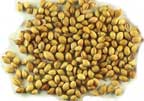 Coriander or dhaniya and fennel or saunf seeds – Coriander seeds are rich in dietary fibre and can help alleviate constipation. Fennel seeds act in the same way. Roasted fennel seeds are chewed as a digestive and mouth freshener after Indian meals.
Coriander or dhaniya and fennel or saunf seeds – Coriander seeds are rich in dietary fibre and can help alleviate constipation. Fennel seeds act in the same way. Roasted fennel seeds are chewed as a digestive and mouth freshener after Indian meals.
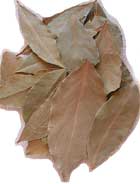 Bay leaves – are seasoning often used dry, whole, or ground in curries and rice preparations. They are an important ingredient of garam masala. Dark green when fresh and olive green when dry, these leaves do not possess any significant nutritional value, but contribute to the overall nutrition of the dishes to which they are added.
Bay leaves – are seasoning often used dry, whole, or ground in curries and rice preparations. They are an important ingredient of garam masala. Dark green when fresh and olive green when dry, these leaves do not possess any significant nutritional value, but contribute to the overall nutrition of the dishes to which they are added.
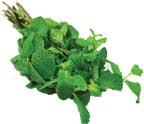 Mint or pudina – is the most popular herb in the world. Its fresh leaves are used for making chutneys, curries, desserts, and drinks. The sun-dried leaves are used for making breads and marinating meats. Mint leaves are abundant in nutrients. Leaves added to boiled water and consumed can have a soothing effect on the digestive system and relieve stomach pain. Mint is a powerful natural diuretic and can alleviate the symptoms of asthma and allergies.
Mint or pudina – is the most popular herb in the world. Its fresh leaves are used for making chutneys, curries, desserts, and drinks. The sun-dried leaves are used for making breads and marinating meats. Mint leaves are abundant in nutrients. Leaves added to boiled water and consumed can have a soothing effect on the digestive system and relieve stomach pain. Mint is a powerful natural diuretic and can alleviate the symptoms of asthma and allergies.
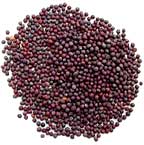 Mustard or sarso/rai – is available in white, yellow, brown, and black colour. Black mustard has the strongest flavour and is used in Indian cooking and to make mustard oil. Mustard seeds are high in magnesium and are often consumed with milk before a meal to improve the appetite. Mustard greens are an excellent source of vitamin C, vitamin E, beta-carotene, and manganese.
Mustard or sarso/rai – is available in white, yellow, brown, and black colour. Black mustard has the strongest flavour and is used in Indian cooking and to make mustard oil. Mustard seeds are high in magnesium and are often consumed with milk before a meal to improve the appetite. Mustard greens are an excellent source of vitamin C, vitamin E, beta-carotene, and manganese.
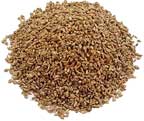 Carom seeds or Ajwain – are used as homemade remedies to treat flatulence and indigestion. Ayurvedic medicines have ajwain as it provides relief in respiratory, kidney, and liver disorders. To get your dose of carom seeds, you could chew these and follow it up by drinking warm water early in the morning. This is also effective in reducing acne.
Carom seeds or Ajwain – are used as homemade remedies to treat flatulence and indigestion. Ayurvedic medicines have ajwain as it provides relief in respiratory, kidney, and liver disorders. To get your dose of carom seeds, you could chew these and follow it up by drinking warm water early in the morning. This is also effective in reducing acne.
 Asafetida or hing – is used in small quantities due to its strong and pungent flavour and because consuming larger quantities could result in side effects like nausea. Asafetida is believed to be effective in curing spasmodic disorders, remedy respiratory problems, and act as a sedative offering a cure for hysteria. It possesses antibiotic properties and is used in pickles and sauces as a preservative.
Asafetida or hing – is used in small quantities due to its strong and pungent flavour and because consuming larger quantities could result in side effects like nausea. Asafetida is believed to be effective in curing spasmodic disorders, remedy respiratory problems, and act as a sedative offering a cure for hysteria. It possesses antibiotic properties and is used in pickles and sauces as a preservative.
 Salt – is essential not only to life, but to good health. It is the most important and undervalued ingredient in our diet and is critical in maintaining hydration. Consuming iodized salt could prevent iodine deficiency and Iodine Deficient Disorders (which affect the mental state). Dietary salt is among the body’s key regulatory variables determining blood pressure and reducing your salt intake or consuming it in excess could have harmful effects.
Salt – is essential not only to life, but to good health. It is the most important and undervalued ingredient in our diet and is critical in maintaining hydration. Consuming iodized salt could prevent iodine deficiency and Iodine Deficient Disorders (which affect the mental state). Dietary salt is among the body’s key regulatory variables determining blood pressure and reducing your salt intake or consuming it in excess could have harmful effects.
Often undervalued in the kitchen, herbs and spices, with their unique flavours, have the property to evoke the senses, heal and protect the body. Experiment and use them in your cooking for they will add “spice” to your life!
Fun Facts
- Pepper was considered so valuable in ancient times that it was the preferred method of bribing government officials. It is one of the oldest-known spices.
- The history of garlic dates back to the time of the pyramid-building Egyptians where it was used as a charm against evil. That vampires are repelled by garlic is ancient folklore.
- In ancient Egypt, cinnamon was valued higher than gold and considered to be a prized gift for monarchs.
- Turmeric, a key element in many ancient Indian ceremonies and Malaysian myths, is believed to have the power to repel crocodiles!
Homemade garam masala
2 tablespoons crushed cardamom
1 tablespoon black pepper
1 tablespoon cloves
1 teaspoon dried ginger powder
1 teaspoon garlic flakes
1 teaspoon coriander seeds
1 teaspoon cumin seeds
2 cinnamon sticks
1 Bay leaf
Roast all the ingredients until the spices become very fragrant. Put the mixture in a grinder and process until spices are very finely ground. Store in an airtight container and use within 3 months.
Simple tips
- Stir frying or blanching keeps flavours and nutrients locked in.
- Cumin and coriander seeds should be dry roasted before they are ground to really bring out their flavour.
- Store spices in airtight containers, as they lose their flavour with exposure and age.
The author is a jewellery designer with a love for spices, gems, mythology and astrology. She can be reached at aaartinarayan@gmail.com.
